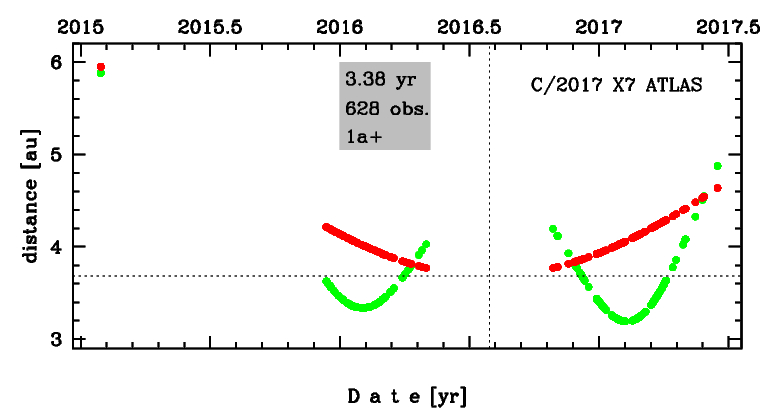C/2015 X7 ATLAS
more info
Comet C/2015 X7 was discovered on 12 December 2015 by Asteroid Terrestrial-impact Last Alert System (ATLAS) Team, that is about 7.5 months before its perihelion passage. Some prediscovery images of this comet were found: taken on 28 January 2015 by Pan-STARRS 1, Haleakala. This comet was observed until 16 June 2017.
Comet had its closest approach to the Earth on 8 February 2017 (5.909 au); about 6 months after its perihelion passage.
Solutions given here are based on data spanning over 2.38 yr in a range of heliocentric distances: 5.95 au – 3.685 au (perihelion) – 4.64 au.
This Oort spike comet suffers small planetary perturbations during its passage through the planetary system that lead to a more tight future orbit with a semimajor axis of about 5,000 au (see future barycentric orbits).
Comet had its closest approach to the Earth on 8 February 2017 (5.909 au); about 6 months after its perihelion passage.
Solutions given here are based on data spanning over 2.38 yr in a range of heliocentric distances: 5.95 au – 3.685 au (perihelion) – 4.64 au.
This Oort spike comet suffers small planetary perturbations during its passage through the planetary system that lead to a more tight future orbit with a semimajor axis of about 5,000 au (see future barycentric orbits).
| solution description | ||
|---|---|---|
| number of observations | 628 | |
| data interval | 2015 01 28 – 2017 06 16 | |
| data type | perihelion within the observation arc (FULL) | |
| data arc selection | entire data set (STD) | |
| range of heliocentric distances | 5.95 au – 3.69 au (perihelion) – 4.64 au | |
| type of model of motion | NC - non-gravitational orbits for symmetric CO-g(r)-like function | |
| data weighting | YES | |
| number of residuals | 1244 | |
| RMS [arcseconds] | 0.43 | |
| orbit quality class | 1a+ | |
| next orbit statistics, both Galactic and stellar perturbations were taken into account | ||
|---|---|---|
| no. of returning VCs in the swarm | 5001 | * |
| no. of escaping VCs in the swarm | 0 | |
| no. of hyperbolas among escaping VCs in the swarm | 0 | |
| next reciprocal semi-major axis [10-6 au-1] | 196.88 – 200.01 – 203.19 | |
| next perihelion distance [au] | 3.659 – 3.6602 – 3.6614 | |
| next aphelion distance [103 au] | 9.84 – 10 – 10.2 | |
| time interval to next perihelion [Myr] | 0.345 – 0.353 – 0.361 | |
| percentage of VCs with qnext < 10 | 100 | |
| next_g orbit statistics, here only the Galactic tide has been included | ||
|---|---|---|
| no. of returning VCs in the swarm | 5001 | * |
| no. of escaping VCs in the swarm | 0 | |
| no. of hyperbolas among escaping VCs in the swarm | 0 | |
| next reciprocal semi-major axis [10-6 au-1] | 196.88 – 200.01 – 203.19 | |
| next perihelion distance [au] | 3.6552 – 3.6564 – 3.6576 | |
| next aphelion distance [103 au] | 9.84 – 10 – 10.2 | |
| time interval to next perihelion [Myr] | 0.345 – 0.353 – 0.361 | |
| percentage of VCs with qnext < 10 | 100 | |
